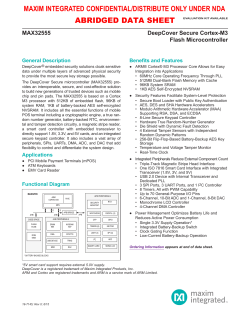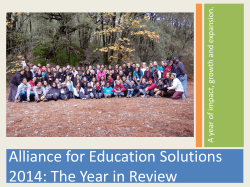
Dr. Dean Grubbs - American Elasmobranch Society
The Florida State University Coastal and Marine Laboratory 3618 Coastal Highway St. Teresa, FL 32358-2702 Telephone: (850) 697-4120 Fax: (850) 697.3822 website: http://www.marinelab.fsu.edu 24 March 2015 AES President Statement: Dean Grubbs I am honored to be a nominee for President of the American Elasmobranch Society. As background, I first joined AES in 1996, during my second year of graduate school, but my ties to the society and its members began much earlier. In fact, my career has largely been directed and shaped by AES stalwarts. Dr. Sonny Gruber (AES founder, first President and first Distinguished Fellow) hired me as a college freshman at the University of Miami in 1988 and gave me my first exposure to field research and I am still heavily involved in his research program to this day. In addition, this is the 20th consecutive year that Sonny and I have taught elasmobranch biology courses together. Dr. Art Myrberg, a renowned ethologist and the 8th AES Distinguished Fellow, was my most influential undergraduate professor. Though I can only muster a small fraction of the charisma Art had as a teacher and lecturer, it is his style that I do my best to emulate. Dr. John Morrissey, the 11th AES President, was a doctoral student during my undergraduate tenure at Miami. Big John was a major influence encouraging me to pursue graduate school and has been an advisor and confidant for 25 years. After graduating from Miami, I entered the doctoral program at the College of William & Mary under the advisement of Dr. Jack Musick, the 6th AES President and 9th AES Distinguished Fellow. A true naturalist with diverse interests, Jack embodies the logic and spirit behind holding joint meetings of herpetologists and ichthyologists, including AES. Jack often had students studying subjects that spanned the taxonomic spectrum of these joint meetings. I thank (and sometimes blame) Jack for fostering these tendencies in me. I interpret the mission of AES as having three components - 1) to support primary scientific research on the chondrichthyan fishes, 2) to promote science education and 3) to provide advisory services that promote conservation, management and sustainable use of chondrichthyan resources. Following the leads of my AES mentors, I am strongly engaged in each aspect of this mission. Research: I am Research Faculty and the Associate Director of Research at the Florida State University Coastal and Marine Laboratory. I maintain a very active lab at FSU dedicated to conducting both basic and applied ecological research on exploited and poorly studied marine and estuarine fishes. Much of this research addresses specific biological gaps necessary for management and conservation of coastal and deep-water elasmobranchs. I also maintain productive collaborations with researchers from numerous agencies and universities, many of whom are active AES members. The heart of my lab has been and is a core of outstanding graduate students that make me look better than I am. Education: Over the past 20+ years, I have taught courses in Biology of Elasmobranch Fishes as well as Ichthyology and Tropical Marine Biology for eight universities from four countries. Students in these courses have included undergraduates, graduate students, public school 1 teachers, employees of NGOs, and the members of the public. I believe public outreach is our duty as scientists if we expect the public to continue to support scientific research. I visit 6-10 public schools each year to talk about sharks and marine research and I frequently give talks to the general public through civic and non-profit organizations, science cafes, fairs and festivals. Advisory Service: I have served as an advisor concerning elasmobranch management and conservation issues for state and federal agencies, regional management councils and international conservation bodies. I have been a member of the IUCN Shark Specialist Group since 2001. I advise the Florida Fish and Wildlife Conservation Commission on shark management issues. I am a member of the NOAA Office of Protected Resources’ Smalltooth Sawfish Recovery Team, NOAA’s SEDAR Advisory Panel for Highly Migratory Species and the South Atlantic Fishery Management Council’s Food Web and Connectivity Team. AES Involvement and Vision: Within AES, I have served as member and chair of the Grant Fund Committee (2007-2010), a member of the Student Award Committee (2009, 2013) and on the Board of Directors (2012-2016). With Dr. Chip Cotton, I co-organized a symposium on the Biology of Deep-Water Chondrichthyans for the 2012 annual meeting. I also served as a panelist for the Student Affairs Committee Workshops at the annual meetings in 2012 (How and why to avoid being labeled a "Shark Scientist") and 2014 (Getting a Job: Preparing in graduate school, applying and making the transition). As a former AES student member, I recognize one of the society’s best attributes is that it is very inclusive. We are a society where members from students that are just starting out to the most senior faculty interact freely and exchange ideas. The AES also has a reputation for being very supportive of student members through a variety of travel, research and presentation awards. The benefits of this collegial and interactive atmosphere are many and the contributions our students make through the activities of the Student Affairs Committee as well as the high-quality research presented at our annual meetings illustrates that student investments are critical to the success of AES. As AES President I would seek to maintain or strengthen our commitment to our student members and increase student membership. I would also seek avenues to foster more interaction between research disciplines and I believe our members could benefit through more interaction with other societies under the JMIH umbrella, perhaps through question-focused symposia that are taxonomically diverse and include multiple societies. Finally, I would continue to support the society’s tripartite mission through my own work and by promoting the work of our members. I would be delighted to give back to the AES through service as President if elected. Sincerely, R. Dean Grubbs, Ph.D. Associate Director of Research Florida State University Coastal and Marine Laboratory email: dgrubbs@bio.fsu.edu 2
© Copyright 2025















